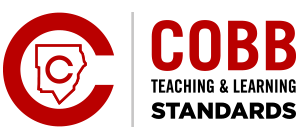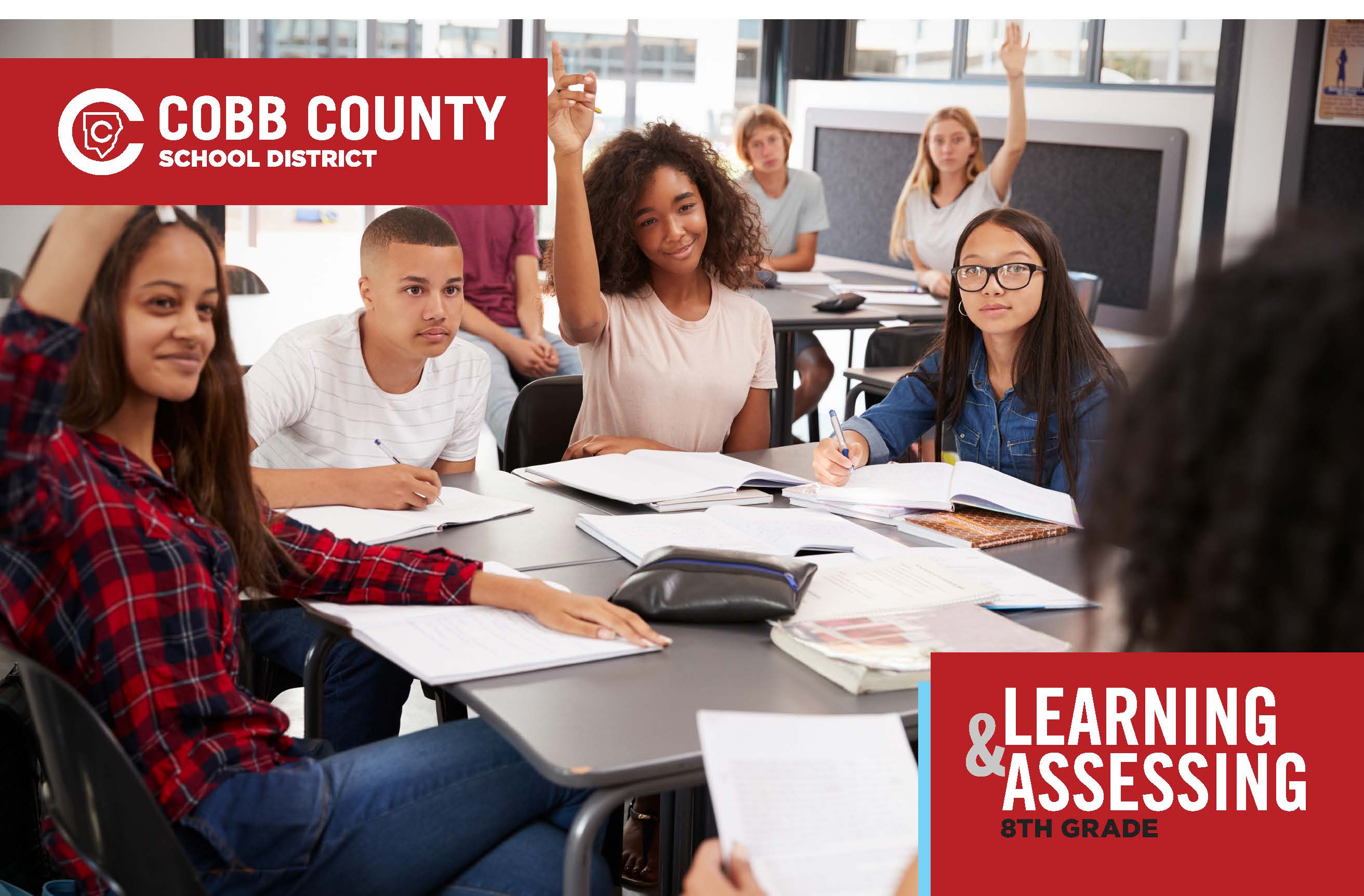8th Grade Learning

What Do Students Learn In 8th Grade?
8th GRADE LEARNING :
The Cobb County School District is committed to providing your child an academic experience that will develop his or her knowledge and skills at every grade level and to ensuring a strong foundation is established for your child to reach his or her greatest potential. Our teaching is aligned with content standards, and our teachers bring those standards to life for your child through various strategies designed to meet your child’s learning strengths and needs.
In Cobb County classrooms, students are immersed every day in learning experiences based on exploration, problem-solving, and critical thinking in all content areas including the core areas of English Language Arts, Mathematics, Social Studies, and Science. Connections classes allow students to enjoy specialized academic content including Career Tech*, Health, Music, Physical Education, Technology, Visual Arts, and World Languages* Excellence in teaching guides your child’s educational experience from Kindergarten to graduation and into life.
* Programming available varies at local schools
ENGLISH LANGUAGE ARTS:
Instruction in grades 6-8 addresses students' increasing maturity and the growing sophistication of their abilities, culminating in the development by the end of grade 8 of students who are ready to succeed in high school. Students should be able to comprehend more challenging books and articles, basing all of their analyses, inferences, and claims on explicit and relevant evidence from the texts. Students will expand on their ability to identify central ideas by identifying how those themes are shaped and conveyed by particular details.
MATHEMATICS:
In Grade 8, instructional time should regularly incorporate the 8 Mathematical Practices, the Framework for Statistical Reasoning, and the Mathematical Modeling Framework through four big ideas of content: (1) numerical reasoning, (2) functional & graphical reasoning, (3) patterning and algebraic reasoning, and (4) geometric and spatial reasoning. Much of the Grade 8 mathematics curriculum focuses on functions and linear relationships as building blocks to algebra and
geometry. In this course, students will create, interpret, solve, and graph linear equations and inequalities in one variable, analyze the connections between proportional and non-proportional lines and equations, extend their knowledge of numerical reasoning and real numbers to include irrational numbers, develop an understanding of the properties of exponents, perform operations with numbers expressed in scientific notation, apply their geometric and spatial reasoning to interpret and solve problems involving the Pythagorean Theorem.
SCIENCE:
In Physical Science, eighth graders delve deeper into the physics and chemistry of the natural world. They explore topics such as the nature of matter, motion and forces, energy principles, light and sound, as well as electricity and magnetism. Through a hands-on, technology-enhanced approach, students develop a strong understanding of these fundamental concepts, laying the groundwork for future scientific studies and preparing them for STEM-related courses and careers.
SOCIAL STUDIES:
In eighth grade, students study Georgia geography, history, government, and economics. While the four strands are interwoven, ample opportunity is also provided for in-depth study of the geography of Georgia and the government of Georgia. U.S. historical events are included, as appropriate, to ensure students understand Georgia’s role in the history of the United States.
CONNECTIONS:
Schools offer varying Connections classes for middle school students. Connections can include, but are not limited to, Health, Physical Education, Visual Arts, Performing Arts, Band, Orchestra, Chorus, Career Tech and Foreign Language. The purpose of Connections is to provide broad and rich exposure to areas that nurture student interest, talent, and skills.
PARENTS TIPS: Reading
Take time this year to consider the academic, extracurricular, and career exploration options available to your child as he or she transitions to high school. Seek the counsel and advisement of the middle school teachers, counselors, and administrators and ask questions about the best placement for your child as he or she transitions. Plan to attend parent informational events that detail the high school experience and also provide suggestions to ease the transition to high school.
How Do We Assess Students In 8th Grade?
Your child will have a variety of classroom assessments that will aid his or her teacher in knowing how to provide the best possible instruction for your child. Also, these assessments will help you know how well your child is learning and what extra support may be needed. In addition, your child will participate in some standardized assessments that are used to gauge how well your child is doing, based upon his or her grade level expectations.
The State of Georgia requires that students, in grades 6-8, participate in the annual administration of state assessments. The state assessment is called the Georgia Milestones Assessment System. Georgia Milestones measures how well students have learned the knowledge and skills in language arts, mathematics, science and social studies. Students in grade 8 will take an End of Grade (EOG) assessment as part of the Georgia Milestones. The EOG will include multiple choice, short answer, and technology-enhanced questions. The language arts EOG has a third section, which focuses on writing.
In the fall, students in 8th grade will participate in the College Board’s PSAT 8/9. This test measures skill levels and academic progress, giving students a foundation for success as they transition to high school.
All students in grades K-9 participate in the universal screening process for reading and math using a digital inventory. Your eighth grader’s progress in reading and math will be measured three times a year.
TESTING IN 8th GRADE:
Mark the Calendar: PSAT 8/9 (formerly ReadiStep): October
8th grade End of Grade (EOG): April-May
HS End of Course (EOC) Assessments (as applicable): May
Question Types: Students respond to multiple-choice questions, called selected-response. They write short answers to grade-appropriate questions. Higher-order thinking skills are employed at all levels of testing. Performance-based assessments and assignments give hands-on opportunities to express learning at different rates and levels.
PARENT TIPS: Assessment
Parents can support students in easing any concern or anxiety about assessment:
- Talk with your child about any tests or assessments.
- Explain that assessment is a natural and important part of any learning. Tests help students understand their thinking better and make improvements for better performance in the future.
- Remind your child to pay attention to the directions and to listen carefully as they are read. Encourage your child to take time to understand the questions before selecting an answer.
- A good night’s rest is the best way to arrive focused on test day!
Remember that assessment is an important and helpful part of learning for students of all ages. Your support and involvement in your child’s education is critical to success in school and in life. Research shows when parents play a key role in their child’s learning, their child’s achievement excels.
What Instructional Resources Are Used In 8th Grade?
CLICK HERE TO DOWNLOAD A LIST OF BOARD APPROVED INSTRUCTIONAL RESOURCES FOR EIGHTH GRADE
CLICK HERE TO DOWNLOAD A LIST OF BOARD APPROVED CTAE LEARNING RESOURCES FOR MIDDLE SCHOOL
Instructional resources are provided to students and teachers to support teaching and learning. The titles listed below have been recommended to our Board by a committee of teachers, parents and community representatives and approved through the textbook adoption process (See Board Rule IFAA-R). Additional resources to enhance the instruction are constantly added by local schools and individual teachers.
Course/Content Area | Resource | Publisher |
English Language Arts | SpringBoard | CollegeBoard |
Mathematics | Custom Developed Mathematics Content for Math 8 | Cobb County School District |
Mathematics | Custom Developed Mathematics Content for Algebra | Cobb County School District |
Science | GA Science & Technology Physical Science | HMH |
Science | Science Dimensions | HMH |
Social Studies | Clairmont Georgia Studies | Clairmont Press |
What Is My Student's Framework For Learning In 8th Grade
8th Grade Teaching & Learning Frameworks
English/Language Arts | Math | Science | Social Studies

Cobb Teaching & Learning Standards - English Language Arts
CLICK HERE TO DOWNLOAD 8th GRADE COBB TEACHING & LEARNING STANDARDS FOR ELA
Cobb Teaching & Learning Standards - Mathematics
CLICK HERE TO DOWNLOAD 8TH GRADE COBB TEACHING & LEARNING STANDARDS FOR MATH
Cobb Teaching & Learning Standards - Social Studies
CLICK HERE TO DOWNLOAD 8TH GRADE COBB TEACHING & LEARNING STANDARDS FOR SOCIAL STUDIES
Cobb Teaching & Learning Standards - Science
CLICK HERE TO DOWNLOAD 8TH GRADE COBB TEACHING & LEARNING STANDARDS FOR PHYSICAL SCIENCE

